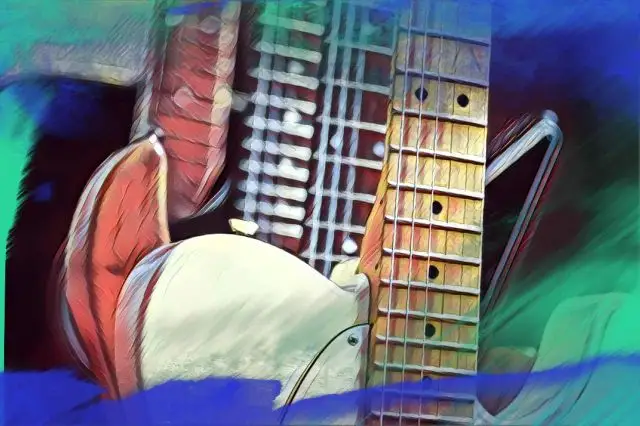There are few debates in the guitar world more enduring or passionately argued than Telecaster versus Stratocaster . It’s the six-string equivalent of Coke vs. Pepsi, Mac vs. PC, Batman vs. Superman. And like all great rivalries, it’s less about who’s “better” and more about what fits the player.
On one side, you’ve got the Fender Telecaster , the no-nonsense, twang-slinging slab of wood that’s powered everything from outlaw country to garage punk. It’s raw, it's rugged, and it's got a tone that can cut through any mix like a hot knife through butter.
On the other hand, the Stratocaster , Leo Fender’s sleeker, sexier follow-up. It’s got curves in all the right places, a tremolo system built for the expressive folk, and enough pickup combinations to make it an absolute workhorse. From Hendrix to Frusciante, it’s been the weapon of choice for players who like their sound smooth, flexible, and slightly unhinged.
But beyond the obvious visual differences, what really sets these two iconic guitars apart? What makes a player reach for one over the other when the lights go up and the amp starts to hum?
In this guide, we’re putting the Strat and the Tele head to head, exploring everything from their origin stories and body shapes to their pickups, bridges, tones, and the musical legends who’ve made each one famous. By the end, you’ll not only understand the differences, you’ll probably know which one belongs in your hands.
Let’s plug in.
A Brief History of the Strat and Tele
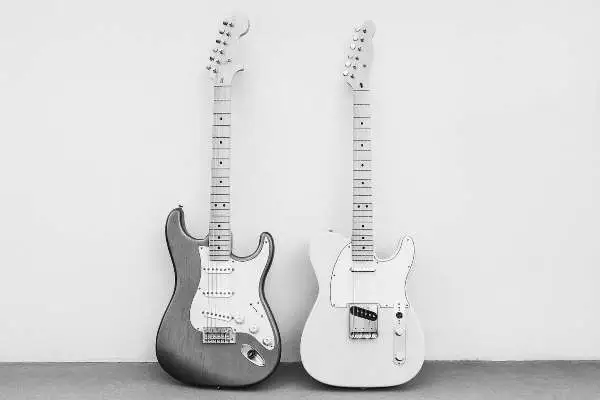
Telecaster: The Original Gangster
Before there was the Stratocaster, before there were offset guitars, before Hendrix set anything on fire, there was the Tele. Introduced in 1950 as the Broadcaster (until Gretsch made a stink about the name), the Telecaster was Leo Fender’s first attempt at a solidbody electric guitar. And it was brilliantly simple .
A single-cut slab of ash, a bolt-on maple neck, two pickups, and just enough chrome to catch the stage lights. The Telecaster was designed to be durable, easy to manufacture, and brutally effective. No frills. No curves. Just a utilitarian tone machine that could take a beating and still stay in tune.
And musicians loved it. Especially the country crowd. That twangy bridge pickup practically invented the Nashville sound. But it didn’t stop there. Blues players like Roy Buchanan , punk icons like Joe Strummer , and even arena rockers like Bruce Springsteen took the Tele and made it their own. It was versatile, it was reliable, and it looked just punk enough to mean business.
Stratocaster: The Space-Age Second Draft
By 1954, Leo Fender had learned a few things. Players loved the Tele, but they had complaints: the body was too square, the bridge was too sharp, and the pickup options were a little limited. So, Leo went back to the drawing board and came back with the Stratocaster .
This was the new girl next door. It had sleek body contours that hugged your ribcage, a tremolo system (called the “synchronized tremolo”), and three single-coil pickups for more tonal combinations than any player had ever seen before.
Where the Tele was built to work, the Strat was built to sing . And it attracted some serious players, including Jimi Hendrix , Eric Clapton , Jeff Beck , and later, artists like John Mayer , Mark Knopfler , and Yvette Young . The Stratocaster became synonymous with expressive, fluid, genre-defying guitar work.
Body & Feel
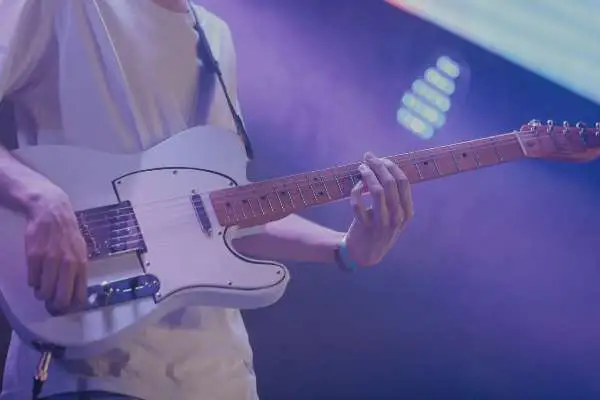
In terms of physical design, the Strat and Tele are like two siblings who inherited very different traits from the same parent. One said, “Let’s keep it simple and solid,” and the other said, “Let’s see how many curves I can pull off without losing structural integrity.”
The Telecaster Body
The Telecaster is as straightforward as it gets. A single-cut body with flat edges and zero contouring — it’s basically the electric guitar equivalent of a cast iron skillet. Is it sleek? No. Does it care? Also no.
That slab-style body might not hug your torso like a Strat, but it’s rugged in a way that screams durability. And let’s not ignore the fact that a Tele can take a literal beating and come out the other side just fine.
The lack of body contours has never bothered me. I played a telecaster live for years, and I always loved the feeling of swinging it over my shoulder. It's such a simple body that you never feel like you're fighting it. I try to think of this simplicity as a design philosophy, not a limitation.
The Stratocaster Body
The Stratocaster has a double-cutaway design that isn’t just for show. It makes upper-fret access way easier, especially if you’re the type who likes to solo past the 15th fret without dislocating your shoulder. Add in the belly cut and forearm contour , and suddenly you’ve got an electric guitar that feels like it was designed by an orthopaedic specialist.
It’s the more ergonomic of the two, no question. Whether you’re sitting down, standing up, or jumping around a stage like you’re auditioning for Warped Tour in 2006, the Strat moves with you. That level of comfort makes a real difference, especially during longer sessions or gigs.
Electronics & Controls
Another major difference between the Telecaster and Stratocaster is what's found under the hood. Their control setups are wildly different, and that can drastically change how you interact with the instrument, especially on stage.
The No-Frills Telecaster
With the Telecaster , you get two single-coil pickups , one volume knob , one tone knob , and a three-way switch . That’s it. No labyrinth of controls, no accidental knob twists mid-solo, no existential crisis trying to figure out which pickup combo you're on.
The Tele’s setup is deliberate . It gives you just enough range to move between biting bridge twang, smooth neck warmth, and a snappy in-between combo, all without a user manual. It’s the kind of setup that rewards muscle memory and keeps your hands focused on playing, not tweaking. Onstage, that level of simplicity is gold.
And while the Telecaster’s bridge pickup is famously bright and twangy, the neck pickup has this rounded, smoky tone that’s surprisingly versatile, especially for jazz, blues, or anything mellow and vibey. If I had to quickly compare the Tele sound to the Strat's, I would say it's a bit thicker and fuller overall.
In my book, much of the Tele sound comes from its stronger fundamental.
It’s a minimalist’s dream. The kind of control setup that says, “You want tone? You earn it.”
More Options and More Flavor with a Stratocaster
Now enter the Stratocaster , Fender’s kitchen sink of tone. It’s got three single-coil pickups , a five-way selector switch , one volume knob , and two tone controls . More moving parts? Absolutely. More possibilities? Definitely.
Where the Tele gives you three distinct voices, the Strat gives you five, and those “in-between” positions (2 and 4) are where the magic lives. That signature “quack” tone, with its slightly phasey, nasal quality, is pure Stratocaster DNA. It’s funky, it’s expressive, and it’s basically the sound of ‘70s pop and ‘90s R&B having a conversation.
The Strat’s neck pickup is another jewel. It has a round, bell-like tone that's perfect for playing clean. Meanwhile, the bridge is snappier than the Tele’s, but usually thinner unless you mod it. And with two tone knobs, you can roll off highs without affecting the whole signal, giving you more control over your sound mid-performance.
Another thing that I notice about the Strat sound (and maybe other players will agree), is that it has a little bit more "air" to it, which I think is due to the associated springs on the bridge.
Of course, no guitar is ever set in stone as you buy it.
You’ll see Teles with humbuckers in the neck, Strats with HSS or HSH setups (humbucker-single-single or humbucker-single-humbucker), coil-splits, push-pulls, you name it. Both guitars are legendary for a reason: they’re platforms , not just instruments.
Bridge & Tremolo Systems
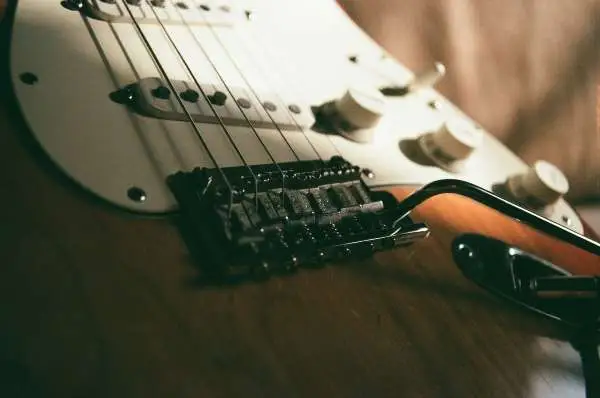
Here’s where things get really philosophical: Do you want a guitar that never lets you down… or one that lets you dive-bomb your way into tonal oblivion?
Telecaster: Built Like a Brick to Play Like a Dream
The Telecaster’s bridge is a masterpiece of industrial-age functionality. You’re looking at a fixed “ashtray” bridge , often with three brass barrel saddles (or six modern ones), and a string-through-body design that anchors each note like it owes you money. This setup gives the Telecaster its famed sustain and that tight, snappy response that just feels right under your picking hand.
Why do players love it? Simple. It’s rock solid . You set it up once, and it stays in tune, stays intonated, and stays out of your way. No springs. No trem cavities. No floating metal contraptions throwing off your bends. The Tele bridge is just there , doing its job without complaint, like a vintage pickup truck that always starts on the first crank.
It’s not fancy, but it’s dependable. And when you’re on stage or in the studio, that kind of stability is priceless.
The Stratocaster’s bridge is a whole different beast with its synchronized tremolo system. This was Leo Fender’s response to guitarists wanting a little more motion in their ocean . It’s built to move , letting you dive, dip, scoop, shimmer, warble, and scream with the push of a whammy bar. It’s expressive, it’s dynamic, and when it’s set up properly, it’s a thing of beauty.
But yes, it can be an intonation nightmare if you don’t know what you’re doing.
There are a few ways to manage that:
- Floating : lets you go up and down in pitch, which is fun, but less stable.
- Decked : rests against the body. This is still flexible but more reliable.
- Blocked : disables trem movement entirely, which basically turns your Strat into a hardtail.
Whatever you choose, the Strat bridge brings a level of tonal flexibility that’s impossible to get with a fixed bridge. It’s a favorite for surf rock dives, bluesy moans, ambient textures, and Van Halen-style theatrics .
Tonal Character
This is where things get deliciously subjective. Tone is the soul of any guitar, and it's what most guitarists spend lifetimes chasing. While both the Telecaster and Stratocaster speak fluent guitar, they’ve got wildly different accents . Whether you’re playing clean, pushing tubes into breakup, or ripping through a fuzz pedal, each guitar responds in its own unmistakable voice.
The Bridge Pickup
Let’s start with the business end, the bridge pickup .
- Telecaster : This is where the Tele earns its reputation for bold, snarling country music twang . It’s brash, punchy, and unapologetically in your face . Perfect for country chicken pickin’ , punk power chords , indie jangle , and even classic rock riffage . Thanks to the steel bridge plate and string-through-body design, there’s a sharp, focused attack.
- Stratocaster : The Strat’s bridge pickup, by comparison, can feel thinner and brighter . It has that high-end sparkle, sure, but unless you’re running it through some gain or a Marshall stack, it can come off a little… polite. That’s why many Strat players swap in a humbucker or a hotter single coil here. You get a bit more meat on the bone. Still, with the right amp settings or some overdrive, it’s the perfect candidate for that classic blues-rock crunch or that searing David Gilmour bite.
Neck Pickup
Now let’s talk neck pickups , aka where the soul lives.
- Telecaster : Surprisingly warm and dark, almost jazz-box moody . It’s not as glassy or defined as the Strat’s, though also not as mellow as a semi-hollow body. However, there’s a charm in that middle-ground smokiness. I've always loved a telecaster for jazz. When recording, I'll often use the neck pickup on my telecaster for rhythm and my Strat for leads.
- Stratocaster : Chef’s kiss. This is the money tone for so many Strat fans. It’s the tone of Jimi Hendrix’s “Little Wing” , of John Mayer’s “Slow Dancing in a Burning Room.” I can best describe it as clean, round, expressive, and crystal-clear without feeling sterile. I love to roll off a little tone to get that syrupy sound, especially with a bit of spring reverb and delay.
The Middle Ground
- Stratocaster : Here’s where the Strat takes the cake. Positions 2 and 4 have the famous “quack” tones that you get from combining pickups (bridge+middle and neck+middle, respectively). These tones are the sound of funk, clean pop, and jangly indie rock . Think Nile Rodgers, Mac DeMarco, or most clean tones you'd hear on a John Frusciante solo.
- Telecaster : You only get three positions , but that middle setting (bridge + neck) has its own magic. It’s full, balanced, and slightly woody. It's also one of my favorites for rhythm parts when I need a bit more clarity and body. There’s no “quack,” but there is warmth and punch in equal measure.
Tonal Matchmaking: Which Guitar for Which Genre?
- Rock : Honestly? Flip a coin. Teles have grit, Strats have shimmer. Depends on whether you want snarling rhythm or soaring leads.
- Jazz : Strat neck pickup or a Tele with a humbucker neck mod. Or, if you’re Bill Frisell or Julian Lage, just use a Tele and make the jazz world deal with it.
- Blues : Strat takes a slight edge here. The neck pickup alone has launched a thousand SRV clones.
- Country : No contest. The Telecaster is country. From Buck Owens to Brad Paisley, it’s the Nashville sound.
- Indie/Punk : Both show up all the time. Teles are minimalist, raw, and cool. Strats are colorful, expressive, and perfect for delay-drenched breakdowns.
Mod Culture & Customization Potential
Some players treat guitars like sacred relics, while others see them as platforms for experimentation. If you’re in the second camp and you like the idea of living life with a soldering iron in one hand and YouTube tutorial in the other, then both Teles and Strats are great.
The Telecaster is mod culture’s golden child. With its simple design, it's ridiculously easy to tinker with . Want to drop in a new pickup? You won’t need to remove a pickguard labyrinth to get to it. Want to replace the bridge? Unscrew it and go. From coil splits to stacked humbuckers , from vintage-style brass saddles to a full-on Nashville Tele three-pickup setup , the Tele is the IKEA furniture of electric guitars.
With that said, Strats aren’t far behind when it comes to mods. In fact, they have a long and storied tradition of player-driven innovation. Eric Clapton added a mid-boost circuit to fatten up his tone, and David Gilmour modded his Strat to unlock all three pickups at once. The HSS and HSH configurations (that’s humbucker-single-single or humbucker-single-humbucker) exist because players wanted more bite from the bridge.
I personally love the added thickness of a humbucker in the bridge position.
The tremolo system , too, invites endless experimentation. You can add locking nuts and roller saddles, or swap in a Floyd Rose for maximum dive bombs.
Notable Telecaster Players & Signature Models
As the long-time blue-collar bruiser of the guitar world, the Telecaster has been strapped on by everyone from Keith Richards , whose iconic rhythm work with The Rolling Stones is practically built into the Tele’s DNA, to Bruce Springsteen , who’s rarely seen without his weathered Esquire-turned-Tele hybrid.
Prince made the Tele sing, shred, and scream in purple rainstorms of funk, while Brad Paisley turned it into a country-shredding machine, and even got his own Road Worn signature Tele that’s every bit as flamboyant and fierce as his playing. Then there’s Richie Kotzen , whose signature Tele is a high-output monster with gold hardware and DiMarzios under the hood, a proper hot rod.
Jazz heavyweights like Bill Frisell and Julian Lage also swear by the Telecaster’s stripped-down magic. They prove the Tele can also be for tone purists who want warmth, bark, and nuance, all in one gloriously simple package.
Notable Stratocaster Players & Signature Models
Then, we have the Stratocaster, which is the soulful shape-shifter of the two.
Jimi Hendrix practically turned it into a religious experience at Woodstock. Eric Clapton made the neck pickup cry. David Gilmour turned his black Strat into a space-age synthesizer on Comfortably Numb . John Mayer’s smooth, blues-drenched tone is all Strat, baby. And John Frusciante of the Red Hot Chili Peppers and Corey Wong of Vulfpeck give shimmering funk rhythms and glassy leads that drip with Strat DNA.
One of my favorite players of all time, Jeff Beck, created a gorgeous signature Stratocaster that sounds as brilliant as it plays.
Strat players often pair their guitars with clean, responsive amps like Fender Twin Reverbs or Dumbles (if you’ve got six figures lying around), letting the pickups breathe and bloom. I've always felt like the "Strat sound" delivers tones like an extension of the player’s fingertips.
Pricing & Entry Points
Have you caught the Fender bug yet?
If so, the next question you might have is: How much is this going to set me back? The good news is that whether you're a beginner picking up your first six-string or a tone-chasing vet with boutique pedals for days, Fender and Squier have something in your budget range.
If you're just getting started, the Squier Affinity Series offers serious bang for the buck. You’ll get classic looks, playable necks, and enough tone to play a show and have people asking, "Yo. What kind of Fender is that?"
For just a little more, the Squier Classic Vibe and Fender Player Series models have upgraded hardware and pickups, which are perfect for gigging or recording musicians on a budget.
In the $800–$1,200 zone, Fender really starts flexing. The Player Plus , Vintera II , and American Performer lines have better finishes, improved electronics, and period-correct mojo. Want vintage tones with incredible tuning stability? This is your playground.
Now, if you have champagne taste, the American Ultra and Custom Shop models are where it's at. You'll find premium woods, noiseless pickups, and hand-rolled necks that feel like velvet. Signature models like Clapton’s Strat or Kotzen’s Tele also have custom electronics and artist-approved tweaks.
Which One Is Right for You?
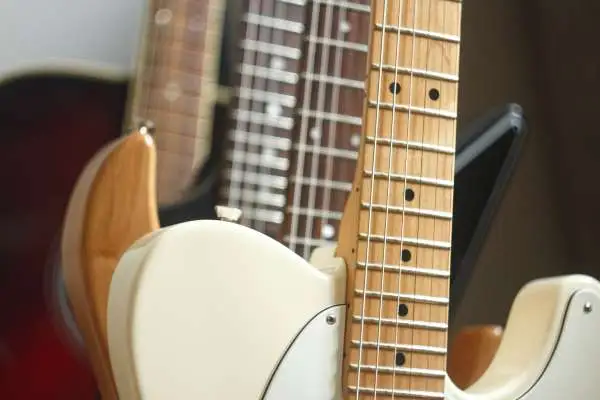
Like I said before, the Telecaster vs. Stratocaster debate isn’t about which is better . It’s about which is better for you . These are two of the most iconic guitars, if not instruments, in history, each with a personality as distinct as their silhouette. So, which one should you pick up? Let’s break it down.
Playing Style
- Love clean tones, bluesy bends, or funky strumming? The Stratocaster’s glassy neck pickup and “quack” positions are practically tailor-made for those styles.
- Craving grit, punch, and that unmistakable twang? The Telecaster’s bridge pickup has a bold, no-frills tone.
From chicken pickin’ to shoegaze, either can cover serious ground, but they take different roads to get there.
Lifestyle
Are you a touring player who needs a tank of a guitar? The Tele’s simple electronics and hardtail bridge are famously low-maintenance. Do you love swapping pickups and tweaking your tone for every session? Strats are a modder’s playground, especially if you want to throw in humbuckers or boost circuits.
If your gear closet already has a Les Paul or a Jazzmaster, ask yourself: do you want something that adds new flavors or complements what you already have?
Try Both, Your Hands Will Know
Specs matter, but feel matters more. Play both guitars unplugged. Notice the neck shapes, the weight, and the way they resonate. Sometimes your hands will make the decision for you before your brain catches up.
If this is your first electric guitar, you're making an excellent choice, as you get plenty of sonic possibilities, easy playability, and tons of solid budget-friendly options to choose from.
Good luck on your journey!


